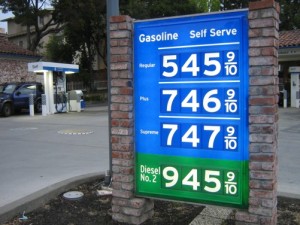by Jack
 One of the many hundreds of boards and commissions that were created by the State Legislature is the one that regulates the tax on gasoline. Wait, did I just say tax? My bad, according to Sacramento that’s a misnomer. It’s not a tax… it’s a revenue neutral regulatory adjustment! Back to the story, so it seems that because California enjoys the highest pump prices in the nation, outside of Hawaii, there has been a drop in gasoline consumption and in turn a drop in tax revenue to the State. (Duh-uh, imagine that) This shocking revelation caused the gasoline tax board to spring into action: Californian’s will see a rise in the cost of gallon of gasoline. The non-elected board is adding on a 3.5 cent “revenue neutral” adjustment, not a tax, effective July 1, 2013.
One of the many hundreds of boards and commissions that were created by the State Legislature is the one that regulates the tax on gasoline. Wait, did I just say tax? My bad, according to Sacramento that’s a misnomer. It’s not a tax… it’s a revenue neutral regulatory adjustment! Back to the story, so it seems that because California enjoys the highest pump prices in the nation, outside of Hawaii, there has been a drop in gasoline consumption and in turn a drop in tax revenue to the State. (Duh-uh, imagine that) This shocking revelation caused the gasoline tax board to spring into action: Californian’s will see a rise in the cost of gallon of gasoline. The non-elected board is adding on a 3.5 cent “revenue neutral” adjustment, not a tax, effective July 1, 2013.
If you continue to drive less or switch to a go kart sized hybrid to cut your personal consumption, your reward will be another revenue neutral adjustment because you can’t beat this system. Only in Sacramento does this make a whit of sense and only government can defeat the first law of econ0mics that says supply and demand regulate the price of a thing.)
The current CA tax on a gallon of gasoline is 37 cents and the state wants to keep it around 10% of the pump price, so what they are telling us is, get used to paying $4 plus a gallon.

Gee Jack, $4.00 a gallon is pretty close to what the greens In California (and Obama) want as part of the plan to force their alternative fuels and lifestyles. This should act as a signal to most low information voters that the democrats are not their friends…it should, but it won’t.
City Journal has a very informative article on the oil in California that could be tapped. It doesn’t pull punches either. Here’s an excerpt that shows what we are withholding from ourselves with the insanity:
Keeping Californians out of work and struggling is a small price to pay to stop that drop in the ocean contribution to climate disruptions or whatever the hell they are calling it this week.